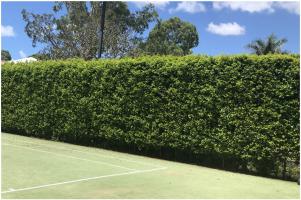Atmospheric Pollution Research ( IF 4.5 ) Pub Date : 2021-05-03 , DOI: 10.1016/j.apr.2021.101070 Nathalie Tomson , Ruby N. Michael , Igor E. Agranovski

|
Urban air quality monitoring and control are becoming increasingly important as the amount of airborne pollutants is directly related to public health. One of the main strategies to improve air quality is to increase the number of plants per unit land surface area across cities through urban greening. In addition to the process of photosynthesis, which minimizes the content of harmful gas impurities into the atmosphere, the planting of relevant vegetation in the form of high-density street vegetation, green walls or green façades, acts as a barrier to the passage of atmospheric aerosol particles into crowded areas. Depending on the availability of local plants, various design strategies could be used to minimise air pollution and achieve maximum air quality. On this basis, it is important to investigate filtration capabilities of a range of locally available plants enabling landscape architects to design the most cost-effective green barriers in various countries. Four common representatives of Australian flora have been selected and tested in this study as promising candidates. A number of configuration scenarios involving manipulation of a layer thickness and biomass packing were tested as potential filters for collection of aerosols sizing from 0.5 μm diameter. The results showed that the plant materials were highly efficient in filtering coarse particles (≥2.5 μm), with efficiencies ranging from 50.1% to 99.9%. The smaller particle sizes were filtered with comparatively lower efficiencies, ranging from 0.6% to 51.3% and 8.6%–79.1% for particles of 0.5 μm and 1 μm diameter respectively. Optimal scenarios were proposed and discussed.
中文翻译:

可能用于绿色屏障的澳大利亚植被去除了颗粒状空气污染物
由于空气中污染物的数量与公共卫生直接相关,因此城市空气质量的监测和控制变得越来越重要。改善空气质量的主要策略之一是通过城市绿化来增加城市每单位地表植物的数量。除了光合作用的过程可以最大程度地减少进入大气的有害气体杂质的含量外,以高密度的街道植被,绿化墙或绿色立面等形式种植相关植被还可以阻止大气通过气溶胶颗粒进入拥挤的区域。根据当地工厂的可用性,可以使用各种设计策略来最大程度地减少空气污染并实现最高的空气质量。以这个为基础,重要的是,调查一系列本地可用工厂的过滤功能,使景观设计师能够设计出各个国家/地区中最具成本效益的绿色屏障。在本研究中已选择并测试了澳大利亚菌群的四个常见代表作为有前途的候选者。测试了许多涉及操纵层厚度和生物质填充的配置方案,作为收集直径从0.5μm大小的气溶胶的潜在过滤器。结果表明,该植物材料对粗颗粒(≥2.5μm)的过滤效率很高,效率范围为50.1%至99.9%。较小的颗粒以相对较低的效率过滤,直径为0.5μm和1μm的颗粒的过滤效率分别为0.6%至51.3%和8.6%–79.1%。



























 京公网安备 11010802027423号
京公网安备 11010802027423号